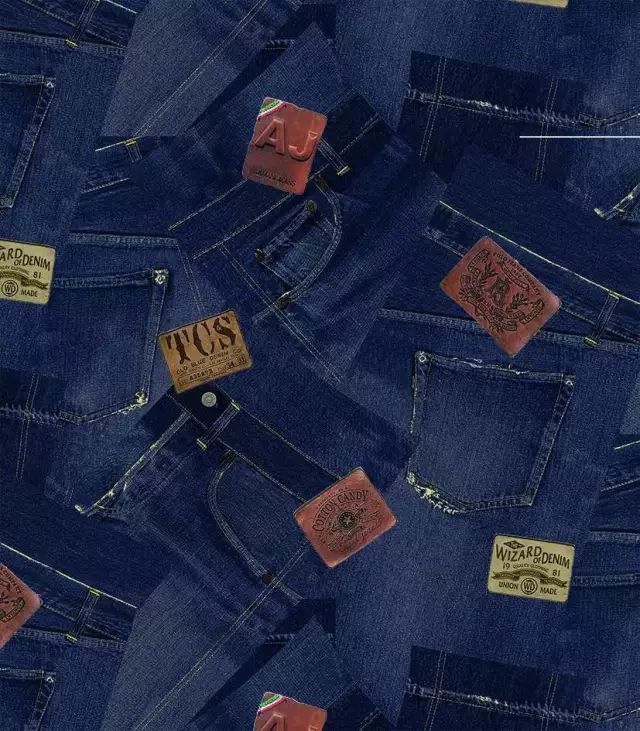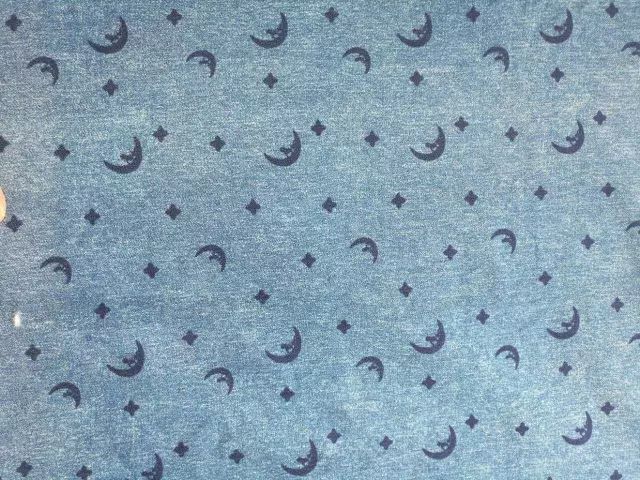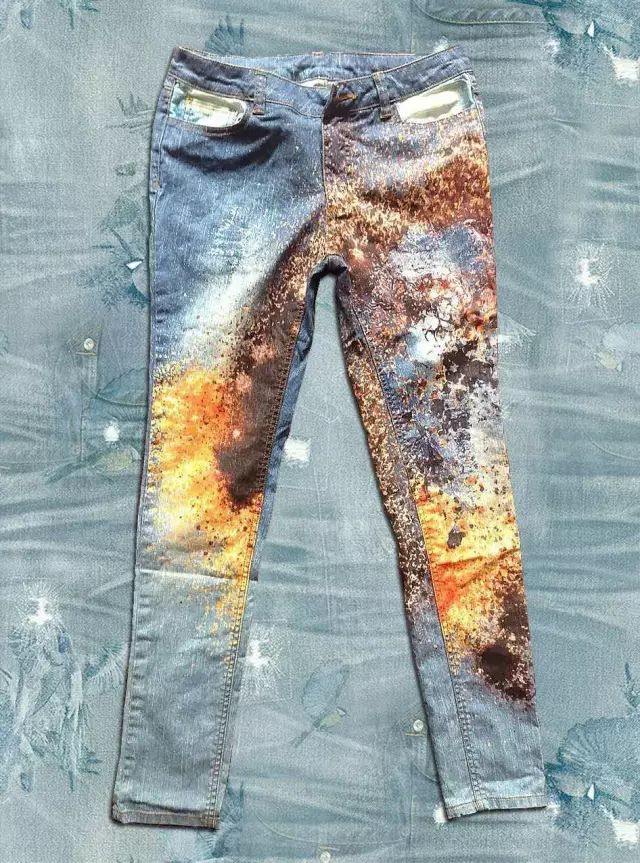Fashion Printing
The traditional jeans main processing process is generally color weaving/dip-dyeing, tailoring, washing and finishing, etc., resulting in a large amount of waste of resources and environmental pollution, especially washing and finishing mostly by hand, low production efficiency and pattern effects will be affected, which makes the production of jeans as the representative of the textile industry to the economy and society's huge promotion and its sexy and fashionable image behind, carrying an unbearable cost of pollution and The cost of inefficient processes.
In particular, the recent "Xintang incident" circulating on the Internet continues to ferment, once again pushing the issue of jeans environmental protection to the forefront. Dyeing factories across the country have experienced the impact of environmental protection policies on the survival and development of enterprises, and the closure of a large number of dyeing factories has brought the business of many entrepreneurs to an abrupt end, and years of effort to zero overnight. The future of the development of the traditional process of the denim industry at the cost of pollution of the environment is worrying, how to effectively solve the ecological and environmental problems of the jeans industry and continuous improvement of production technology, improve production efficiency, improve product quality is imminent.
Jeans are loved by the public because they are fashionable, comfortable, wearable and diversified in style and casual, and are listed as the "top of the line". Traditional jeans are generally processed by color weaving/dip-dyeing, tailoring, washing and finishing, resulting in a large amount of waste of resources and environmental pollution, especially washing and finishing by hand, low production efficiency and pattern effects will be affected, which makes the production of jeans as the representative of the textile industry to the economy and society's huge promotion and its sexy and fashionable image behind, bearing the unbearable cost of pollution and The cost of inefficient processes.
In particular, the recent "Xintang incident" circulating on the Internet continues to ferment, once again pushing the issue of jeans environmental protection to the forefront. Dyeing factories across the country have experienced the impact of environmental protection policies on the survival and development of enterprises, and the closure of a large number of dyeing factories has brought the business of many entrepreneurs to an abrupt end, and years of effort to zero overnight. The future of the development of the traditional process of the denim industry at the cost of pollution of the environment is worrying, how to effectively solve the ecological and environmental problems of the jeans industry and continuous improvement of production technology, improve production efficiency, improve product quality is imminent.
As an emerging fashionable and environmentally friendly garment, printed jeans produced by digital wet transfer technology will have a huge consumer base and market with unlimited potential.



2
New technology: wet transfer printing combined with digital creativity
Digital wet transfer technology is a cotton film wet transfer printing technology independently developed by Jingxiang Digital, which combines with digital creative technology to develop a high-quality printed jeans processing process. The main process technologies developed are as follows.
(1) Design digital pattern.
(2) Making printing film: using reactive dye gravure ink to print film, or digital spray painting of flower film to get printing film.
(3) Jeans fabric dipping and rolling printing auxiliaries: the white embryo fabric for making jeans is dipped and rolled with printing auxiliaries through the rolling car of the wet transfer printing machine.
(4) jeans fabric transfer printing: the white embryo fabric of jeans dipped and rolled with printing aids is laminated with the printing film, and then the printing operation is realized through the wet transfer processing of the transfer machine.
(5) steaming finishing: drying and steaming treatment of the printed jeans fabric.
(6) Cutting and sewing: The jeans fabric after steaming finishing is cut and sewn with large visual precision positioning to get printed jeans.
Digital wet transfer printing technology can effectively eliminate the traditional jeans dyeing and manual washing and finishing processes, which can greatly improve the quality of jeans products while saving water and environmental protection significantly. The technical innovation points are mainly shown as follows.
(1) Digital creative technology ensures product quality. Using 3D CAD creative software, the finished jeans can be designed in advance and transformed into 2D flat printing and cutting size. The technology can also change the color limitations of traditional jeans of blue, gray and black, fine color printing or double-sided printing, making jeans more fashionable.
(2) Direct printing pattern on white blank fabric, energy saving and environmental protection, greatly improving production efficiency. Digital wet transfer printing technology can simulate any washing effect of jeans and directly implement transfer printing, breaking the tradition, eliminating the yarn dyeing link and eliminating the traditional manual washing link to the greatest extent, achieving high precision, high productivity, multi-color, high fastness, low cost, low water consumption, low pollution and non-toxic to the body.
(3) Adopt intelligent large vision laser cutting technology to improve cutting and sewing efficiency. Adopting intelligent large vision laser cutting machine to cut and trim the printed jeans pieces with fast, precise, material-saving and low-cost, which solves the problems of inefficient, high-cost and inferior products of manual positioning and trimming and makes the fast flowing sewing operation of jeans a reality.
(4) Produce targeted and diversified style jeans based on denim base fabric and customer requirements. Digital wet transfer technology technology can also produce denim base cloth, clothing enterprises can, according to customer requirements, on the basis of the base cloth, and then additional other patterns or deep processing technology, such as laser marking process instead of sanding effect, the production of targeted, diversified jeans style, so that jeans to maintain the classic style at the same time, more fashionable and environmentally friendly.
3
Can the advantages of "three low and one high" touch you?
(1) Short process. Using jeans printing process technology and production process, the required pattern pattern and texture effect is printed onto the denim at one time, eliminating the need for traditional jeans to be manually hand-washed, polished, color-coded and other process links, and finally just lightly rinsed. It greatly shortens the production process and provides production efficiency.
Traditional production process: white yarn - dyeing yarn - color fabric (fabric treatment) - cutting - sewing - manual washing and finishing - finishing - packaging, or, white blank fabric - dyeing - color blank fabric (fabric (fabric treatment) - cutting - sewing - manual washing and finishing - finishing - packaging which, manual washing and finishing is generally: priming processing (hand sewing, edge grinding - desizing - fermentation grinding - chlorine bleaching - dechlorination - dewatering, drying - spraying potassium permanganate - over oxalic acid - washing) - set of dyeing processing (dyeing - dewatering, drying - spraying (resin - wrinkle - saw oven baking)
Digital wet transfer technology production process: white embryo cloth (fabric processing) - CAD software design jeans pattern - digital sample - gravure plate making - printing PET film - cloth printing - Drying, steaming finishing - large visual precision positioning cutting - sewing - rinsing - after finishing - packaging
(2) Low cost. Digital wet transfer technology from design, plate making, auxiliaries, ink, coating film, transfer equipment, etc. are developed and produced by Jingxiang Digital independently, and the original pattern is copied and reproduced for mass production. The production of jeans by this process is about 5 yuan cheaper than the traditional production method (calculated at 40 yuan per pair on average), with a perfect combination of low cost and high efficiency.
(3) Low pollution. Digital wet transfer printing technology requires a small amount of water for nitrocellulose washing in the finishing process, the water used in the washing process is only about 1/5 of the traditional process, the color of the wastewater is only 1/20 of the traditional screen printing, the CODCR emission is about 100mg/L (1/5 of the traditional), especially the traditional washing and finishing process does not require a large amount of lead, cadmium and other heavy metal compounds and nonylphenol, octylphenol, perfluorooctane Juan acid In particular, we do not need to use a lot of lead, cadmium and other heavy metal compounds and nonylphenol, octylphenol, perfluorooctanoic acid, benzidine, formaldehyde and other color stripping treatment jeans, not only to minimize the pollution of the environment, but also to achieve the purpose of comfortable wearing, non-toxic and harmless to human body, no skin allergic carcinogenic chemical residues.
(4) High quality. As a supporting technology product, Jingxiang Digital has developed as many as ten kinds of color reactive dyes for the printing process, and the color fastness is up to the fourth grade, which is higher than the fastness of traditional indigo and sulfur dyes for jeans, and it has achieved the effect of no color loss in washing and long-lasting as new.
(5) Creative novelty. The use of digital wet transfer technology, the brand clothing designers can create jeans pattern, passive waiting for the effect of washing for active creativity, will greatly enrich the jeans pattern types, enhance brand recognition, and intuitive and easy to see, what you see is what you get. Digital wet transfer technology combines modern computer technology, chemical technology, mechanical automation technology and printing technology to create a new environmental protection jeans production method with high speed, high efficiency, low cost, high precision and multiple colors.
4
Digital wet transfer printing technology and its characteristics
Digital wet transfer printing and thermal sublimation transfer printing comparison: thermal sublimation transfer printing can only be suitable for tapestries - the type of fabric, the application has - certain limitations, generally transfer printing with sublimation method, from the transfer paper to the fabric of the dye can not be fully absorbed into the internal fibers, there is always a part of the dye residue on the surface of the fabric, become transfer The reason for the poor color fastness of the printed fabric. Secondly, the sublimation method of transfer printing with ink are used solvent formulation, the recycling of waste transfer paper has great difficulties, and the production of transfer paper is a serious environmental pollution. Due to the above factors, the entire production process of printing transfer paper and transfer printing to fabric can not meet the standard of entering the market of developed countries, resulting in the lack of competitiveness of the products of thermal transfer printing, can not break through the green barriers in the international market.
Digital wet transfer printing it has significant advantages in the printing of cotton, wool, silk and other natural fiber fabrics. Due to the use of water-soluble dyes, such as reactive dyes or weak acid dyes, disperse dyes, etc., the method is to print the appropriate dye ink on the plastic film with a digital engraved intaglio plate to print out the pattern or text. The fabric is rolled through the auxiliaries required for color fixation and then enters the transfer at the same time as the printing film.
Contact: Jeanne yang(MISS)
Phone: 13912652341
E-mail: [email protected]
Add: Room A2216/A2217,Double-Star Building,No 567 New South Middle Road, KunShan City JiangSu Province ,China.